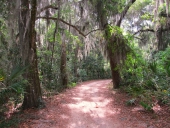Here's one way to tell the difference between zone 8 and zone 9: loquat trees. If the loquats have fruit on them in April, it was a zone 9 winter. Last year, I could find bearing loquats in Augusta and Columbia. This year, no such luck.
The difference between zones 8 & 9 are subtle, since both will have hard freezes. With zone 9 though, you will have a lot more making it through the winter than if the lows drop into the teens a lot, like a typical zone 8 winter. This past winter was a little unusual, in that the cold hung in through March and even plants that do well in cool weather were having trouble. I've never had such a poor crop of peas and potatoes as I had this year. Usually, by April they are in good shape and ready to start producing. This year when April came, they were barely emerged from the ground.
For deciduous fruit trees, it's not really the zone that matters (i.e., the absolute lows during the winter), but the number of chill hours. They need their winter rest, and that is determined by the number of hours below 45F that are racked up in the winter months. When you buy fruit trees, a good grower will be able to tell you the number of chill hours the tree requires. You can then look that up for your particular area (here's a link to some
CSRA stats), and then select varieties that will be OK for your area. With the climate changing, there may be fewer chill hours in 10 or 20 years, so if a tree needs 1200 and your area only averages 1000, better ditch that selection and go shop for one that only needs 800 or fewer. I believe there are some cherry varieties that can produce with as little as 800 chill hours. You may also want to try
Krauter Vesuvius plums, it's either a small plum or a big cherry, and this year the ones in Augusta seem to have a nice crop of fruit on them. I have a few that I started from cuttings last fall. I'm just a little disappointed by the low percentage of cuttings that actually took.













 1
1






















